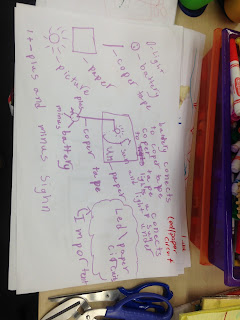The next step of the process was to introduce the students to the elements they would be using to make their storyboards interactive. We started with having the different materials that would be available for them to play around with and try to become familiar with how they worked. The options were Makey Makey (http://www.makeymakey.com/) , LittleBits (http://littlebits.cc/), simple motors, and paper circuits (https://chibitronics.com/) and LED lights. Makey Makey turns everyday objects into touchpads that students connected to sounds they recorded in Scratch. LittleBits are simple magnetic connective circuits. Paper circuits by Chibitronics are LED lights and copper tape that can be taped to cardboard and paper. The simple motors we purchased from Amazon with AAA battery packs. The petting zoo allowed students to walk around and play with the options and familiarize themselves with how they worked so when they moved to the planning stage they had a idea of how everything worked.
Then we assigned the students their interactive element. We assigned the elements for two reasons, one so that each story had four different interactive elements and second so that we would have enough of the materials to share across the grade.
Then the students did their planning. They designed what their storyboard would look like and how they would use their interactive element with their section of the legend. Students had to think about how the interactive element would highlight an important moment in their section of the story. They also planned out what materials they would use. Then they started making!
The final step will be our share out! The whole third grade will share their storyboards in a share out day. Students are so excited to share their boards with their grade mates as well as share their work.







No comments:
Post a Comment
Note: Only a member of this blog may post a comment.